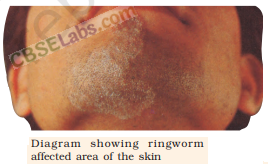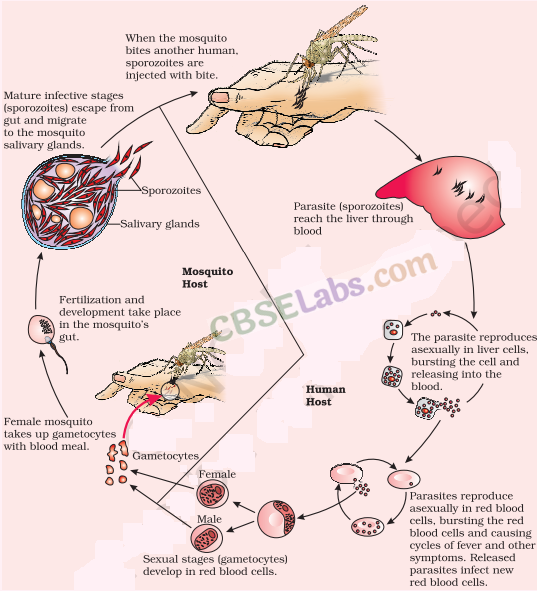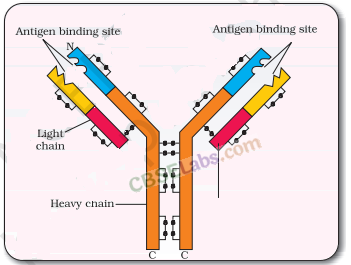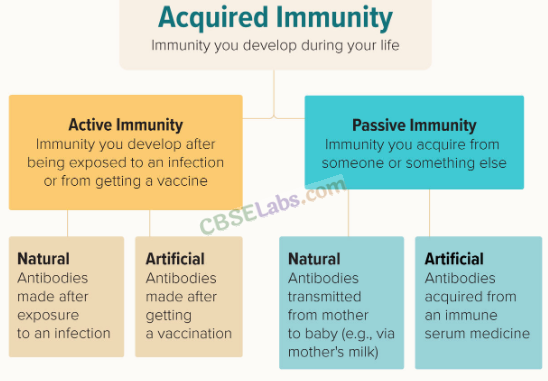Human Health and Disease – CBSE Notes for Class 12 Biology
NCERT Solutions Maths Physics Chemistry Biology Science
Health, Common Diseases in Human and Immunity:
1. Health
is defined as a state of complete physical, mental and social well-being.
(i) The factors which affect human health are:
(a) Genetic disorders (b) Infections (c) Lifestyle.
(ii) Balanced diet, personal hygiene and regular exercise are very important to maintain good health.
(Hi) Awareness about diseases and their effect on different body functions, vaccination against infectious diseases, proper disposal of wastes, control of vectors, maintenance of hygienic food and water resources are necessary for achieving good health.
2. Disease
is a state when functioning of one or more organs or systems of the body is
adversely affected, characterised by various signs and symptoms.
Diseases can be divided broadly into the following two categories depending on the
modes of transmission
I. Infectious diseases which easily transmit from one person to another, e.g. AIDS, common cold, etc.
II. Non-infectious diseases which does not transmit from one person to another, e.g. cancer, diabetes, etc.
(i) Disease causing organisms are called pathogens, e.g. bacteria, viruses, fungi, protozoans, helminthes, etc.
(ii) The above described pathogens enter the body by direct contact, contaminated food and water, droplet infection, etc.
(iii)The pathogens multiply in body cells, interfere with normal vital activities, cause morphological and functional damage.
(iv) Infectious diseases can be divided into certain categories, based on the type of pathogen
Infectious Diseases
Bacterial Viral Protozoan Fungal Helminthic
e.g. pneumonia, e.g. common cold, e.g. amoebiasis, e.g. ringworm, e.g. ascariasis, ,
plague, typhoid, polio, etc. malaria, etc. athelete’s foot, etc. filariasis, taeniasis, etc.
diphtheria, etc

Some diseases are transmitted by vector, i.e. mosquitoes like dengue (Aedes aegypti); chikungunya (Aedes aegypti, Aedes albopictus) and malaria (.Anopheles).
3. Some of the common infectious diseases are:
I. Bacterial Diseases
(i) Typhoid is caused by bacterium (Salmonella typhi).
(a) S. typhi enters the small intestine through food and water contaminated with them and migrate to other organs through blood.
(b) Intestinal perforation and death may occur in severe cases.
(c) Widal test is a confirmation test for typhoid.
(d) Symptoms are high fever (39-40°C), weakness, stomach pain, constipation, headache and loss of appetite.
(ii) Pneumonia is caused byStreptococcus pneumoniae and Haemophilus influenzae.
(a) These bacteria infect alveoli of the lungs. The alveoli get filled with fluid causing decrease in respiratory efficiency of the lungs.
(b) Pneumonia spreads by inhaling droplets/aerosol from infected individuals or even by sharing glasses and utensils with patients.
(c) Symptoms of pneumonia are fever, chills, cough, headache, etc.
(iii) Dysentery, plague, diphtheria, etc., are some other examples of bacterial diseases.
II. Viral Disease
Common cold occurs due to a group of viruses called rhino viruses.
(a) These viruses infect the nose and respiratory passage but not the lungs.
(b) Common cold is characterised by nasal congestion and discharge, sore throat, hoarseness, cough, headache, tiredness, etc., which generally last for 3-7 days.
(c) The infection occurs due to cough or sneezes of an infected person, either inhaled directly or transmitted through contaminated objects such as pens, books, cups, computer’s keyboard or mouse, etc.
III. Protozoan Diseases
(i) Malaria is caused by a protozoan, Plasmodium sp. (P. vivax, P. malariae and P. falciparum).
(a) P. falciparum causes most serious kind of malaria, i.e. malignant malaria which can be fatal.
(b) Female Anopheles mosquito is the vector of Plasmodium, which transfer the sporozoites (infectious form) in human body.
(c) Life cycle of Plasmodium is given in the figure.

• The malarial parasite requires two hosts to complete its life cycle, i.e. human and mosquito.
• Plasmodium enters the human body as sporozoite, through the bite of infected female Anopheles mosquito.
• Parasites initially multiply within the liver cells and then attack the Red Blood Cells (RBCs) causing their rupture.
• Rupture of RBCs release a toxic substance called haemozoin. Haemozoin causes chill and high fever recurring every 3-4 days.
• When a female Anopheles mosquito bites an infected person, these parasites enter the mosquito’s body and undergo further development.
• The parasites multiply within them to form sporozoites that are stored in their salivary glands.
• When these mosquitoes bite a human, the sporozoites are introduced into his/her body, initiating the events mentioned above.
(d) Antimalarial drugs used for the treatment are quinine and chloroquin.
(e) Malaria can be prevented by killing mosquitoes by spraying DDT, BHC, etc., and using insect repellents, mosquito nets, etc.
(ii) Amoebiasis (amoebic dysentery) is caused by an intestinal endoparasite, Entamoeba histolytica, which is found in large intestine of humans.
(a) Carrier of pathogen is housefly. It transmits the parasite from faeces of infected person to the food, thereby contaminating them.
(b) Infection takes place mainly through the contaminated food and water.
(c) Symptoms are abdominal pain, constipation, cramps, faeces with excess mucous and blood clots.
IV. Fungal Disease
Ringworm is caused by many fungi of genera Microsporum, Trichophyton and Epidermophyton.
(i) Infection occurs through contact with an infected person or from soil and through the use of towels, clothes, combs, etc., of an infected person.
(ii) Heat and moisture help these fungi to grow in regions like skin folds as in groin or between the toes.
(Hi) Symptoms of ringworm are appearance of dry, scaly lesions on various parts of the body such as skin, nails and scalp accompanied by intense itching.
V. Helminthic Diseases
(i) Ascariasis is caused by an intestinal endoparasite of human, Ascaris lumbricoides commonly called as roundworm.
(a) Infection occurs as the eggs of parasite are excreted along with the faeces of infected person, which contaminate water, soil, plants, etc.
(b) Infection reaches to human beings through contaminated vegetables, fruits and water, etc.
(c) Symptoms of disease are abdominal pain, indigestion, muscular pain, fever, anaemia, nausea, headache and blockage of intestinal passage.
(ii) Filariasis/Elephantiasis is caused by filarial worms, Wuchereria bancrofti and Wuchereria malayi.
(a) Culex mosquito (female) is the vector.
(b) Genital organs also get affected leading to their deformation.
(c) Symptoms are inflammation of organs in which they live for many years, normally affect lymph vessels of lower limbs resulting in swelling hence, called elephantiasis.
4. Prevention measures to avoid infectious diseases are:
(i) Maintenance of personal and public hygiene is important.
(ii) Personal hygiene includes keeping the body clean, consumption of clean drinking water, food, vegetables, fruits, etc.
(iii) Public hygiene includes proper disposal of waste excreta, periodic cleaning and disinfection of water reservoirs, pools, cesspools and tanks.
(iv) Eradication of vectors and destroying their breeding sites.
(v) Mosquito nets, repellants should be used.
(vi) Vaccination and immunisation programmes for diseases should be strictly followed.
(vii) Use of antibiotics and other drugs can significantly keep away infectious diseases.
5. Immunity
is the capacity of an organism to resist or defend itself from the development of a disease. It is of the following types, as shown below:

I. Innate immunity
is present from birth and is inherited from the parents.
(i) It is non-specific.
(ii) It consists as following types:
(a) Physical barriers prevent entry of microorganisms in the body e.g. skin, mucus coating of the epithelium lining the respiratory, gastrointestinal and urogenital tracts.
(b) Physiological barriers prevent microbial growth in the body, e.g. acid in the stomach, saliva in the mouth and tears from eyes.
(c) Cellular barriers phagocytose and destroy microbes. For example, some WBCs like Polymorphonuclear Leukocytes (PMNL), monocytes and natural killer cells (type of lymphocytes) in the blood as well as macrophages in tissues.
(d) Cytokine barriers are virus-infected cells, which secrete proteins called interferons. They protect non-infeeted cells from further viral infection.
II. Acquired immunity
is not present from birth and develops during an individual’s life
time.
(i) It is pathogen specific and characterised by memory.
(ii) When it encounters a pathogen for the first time, it produces a response called
primaiy response, which is of low intensity.
(iii) Further encounter with same pathogen produces highly intensified secondary or
anamnestic response due to memory of the first encounter.
(iv) Immune responses are produced by two types of lymphocytes:
(a) B-lymphocytes or B-cells produce an army of proteins (in response to pathogens) called antibodies in blood.
(b) T-lymphocytes or T-cells help B-cells to produce antibodies.
(v) Types of acquired immunity:
(a) Humoral immune response or Antibody Mediated Immunity (AMI) It is mediated by antibodies present in blood and lymph.
(b) Cell-mediated immune response or Cell Mediated Immunity (CMI) It is mediated by T-lymphocytes. The graft rejection during organ transplantation, because of the ability to differentiate between self and non-self, is due to the cell-mediated immunity.
(vi) Antibodies are immunoglobulin molecules (Ig). These are of five types:

(a) Each antibody molecule has four peptide chains, i.e. two small called
light (L) chains and two longer called heavy (H) chains. Hence, an antibody is represented as H^.
(b) An antibody seems like a Y-shaped structure.
6. Acquired immunity is as following two types:

7. Vaccination and immunisation
The principle is based on the property of memory of immune system.
(i) Vaccination is the process of introduction of weakened or inactivated pathogens or proteins (vaccine) into a person to provide protection against a disease.
(ii) Immunisation is a process by which the body produces antibodies against the vaccine (primary response) and develop the ability to neutralise pathogens during actual infection (secondary response), i.e. the body become immune to that antigen or infection.
(iii) Vaccine generates memory B and T-cells that recognise the pathogens on subsequent exposure and produce an intense immune response.
(iv) In case of requirement of quick immune response like tetanus infection, preformed antibodies are injected into the patient. This is called passive immunisation.
(v) Recombinant DNA technology has produced antigenic polypeptides of pathogen in bacteria or yeast. This allowed large scale production of vaccine, e.g. hepatitis-B vaccine from yeast, etc.
8. Human immune system
includes (i) lymphoid organs (ii) immune cells (iii) soluble molecules like antibodies (iv) lymphoid tissues.
Lymphoid organs These are the organs where origin and/or maturation and proliferation of lymphocytes occur. They are as following two types:
(a) Primary lymphoid organs are the sites where lymphocytes differentiate and mature to become antigen-sensitive, e.g. bone marrow and thymus.
In bone marrow, all blood cells including lymphocytes are produced and B-lymphocytes mature.
Thymus is a lobed organ, located near the heart and beneath the breastbone.
It reduces as the age increases. T-lymphocytes develop and mature in thymus.
(b) Secondary lymphoid organs provide the sites where lymphocytes interact with the antigen and proliferate to become effector cells, e.g. spleen, lymph nodes, tonsils, Peycr’s patches of small intestine and appendix.
Spleen is a large, bean-shaped organ which contains lymphocytes and phagocytes.
It acts as a filter to trap blood-borne microbes and contain a large pool of erythrocytes.
Lymph nodes are small solid structures along the lymphatic system. Their function is to trap microorganisms or other antigens that enter the lymph and tissue fluid. Mucosal Associated Lymphoid Tissue (MALT) is formed of the masses of lymphoid tissue, lining the mucosa of respiratory, digestive and urogenital tracts. About 50% of lymphoid tissue in human body is formed by MALT.
9. Allergy
is a hypersensitive reaction of the immune system to certain antigens present in the environment.
(i) Allergens produce immune response in an individual, e.g. pollen grains, animal dander, dust, feathers, etc.
(ii) IgE antibodies are produced in response to allergens.
(iii) Allergy is due to chemicals like histamine and serotonin released from the mast cells.
(iv) Symptoms of allergy are sneezing, watery eyes, running nose, difficulty in breathing.
(v) Antihistamine, adrenaline and steroids are taken to reduce the symptoms of allergy.
10. Autoimmunity
is an abnormal immune response in which immune system of the body starts arthritis.
rejecting its own body cell or self cells and molecules, e.g. Rheumatoid
11. AIDS or Acquired Immuno Deficiency Syndrome
was first reported in 1981 in USA.
(i) The causative agent is Human Immunodeficiency Virus (HIV).
(ii) HIV belongs to the group of viruses called retrovirus. It has RNA genome enclosed in an envelope.
(iii) HIV is transmitted by
(a) Sexual contact with infected person.
(b) Transfusion of contaminated blood and blood products.
(c) Sharing infected needles.
(d) Infected mother to unborn child through placenta.
(iv) People, who are susceptible to infection are:
(a) Drug addicts, who take intravenous drug injections.
(b) Individuals who are involved with multiple sexual partners.
(c) Individuals who require repeated blood transfusion.
(d) Children born to HIV positive mother.
(v) Modes of HIV infection:
(a) Virus enters the macrophages, after entering the body of a person.
(b) RNA gets replicated to form viral DNA by enzyme reverse transcriptase.
(c) Viral DNA gets incorporated into the host cell DNA and directs the infected cells to produce virus particles.
(d) Macrophages continue to produce virus particles and thus, acts as HIV factory.
(e) These virus particles enter into helper T-lymphocytes (TH cells) in the blood, where they continue to replicate and produce viral progenies.
(f) The number of helper T-lymphocytes progressively decreases in the body of the infected person.
(g) As the number of T-cells decrease, the immunity also decreases. As a result, person cannot produce any immune response even against common bacteria like Mycobacterium, parasite like Toxoplasma, viruses and fungi.
(h) ELISA (Enzyme Linked Immuno Sorbent Assay) is a widely used diagnostic test for AIDS.
(i) Treatment with anti-retroviral drugs is only partially effective.
(vi) Preventive measures for HIV infection are:
(a) National AIDS Control Organisation (NACO) set-up in 1991 and other NGOs educate people about AIDS.
(b) Role of WHO to prevent HIV infection:
* Ensure use of disposable syringes and needles.
* Ensure keeping blood banks safe from HIV.
* Free distribution of condoms.
* Prevention of drug abuse.
* Discouraging unsafe sex and encouraging regular check-up.
12. Cancer
can be defined as an uncontrolled growth or proliferation of cells without any differentiation.
(i) In our body, cell growth and differentiation is highly controlled and regulated.
(ii) The cancer cells divide repeatedly with uncontrolled cell divisions. They do not require extracellular growth factors.
(iii) Cancer cells lost the property of contact inhibition (contact with other cells inhibit the uncontrolled growth).
(iv) The repeated division of cancerous cells, form a large mass of cells called tumours.
(v) Cancer cells move from tumour to new sites through blood for forming secondary tumours. This invasion of cancer cells from one part to other parts by the body fluids is called metastasis.
(vi) Types of tumour and differences between them:
vii) Cancer causing viruses are called oncogenic viruses. They have genes called viral oncogenes.
(viii) Normal cells have genes called cellular oncogenes (c-onc.) or proto oncogenes, which are present in inactive state, but under certain conditions (like mutation) could lead to oncogenic transformation of the cells.
(ix) Carcinogens are cancer causing agents. They may be
(a) Chemicals As in cigarette smoke, benzopyrene, dyes, paints, etc.
(b) Biological Oncogenic viruses, some parasites, etc.
(c) Physical Ionising radiation like X-rays and y-rays, non-ionising radiations like UV-rays.
(x) Cancer can be detected by the following methods:
(a) Blood and bone marrow tests for increased cell counts.
(b) Biopsy and histopathological studies of the tissue.
(c) Radiography by X-rays, to detect cancer of the internal organs.
(d) Computed Tomography (CT) using X-rays, to generate a 3-D image of internal tissue.
(e) Resonance imaging involves use of non-ionising radiation and strong magnetic field to detect pathological and physiological changes in living tissue.
(f) Monoclonal antibodies against cancer-specific antigens are also used for cancer detection.
(xi) Treatment of cancer involves following methods:
(a) Surgery Tumours are removed by surgery to check further spread of cancer cells.
(b) Radiation therapy Tumour cells are irradiated by lethal doses of radiation, taking care to protect the surrounding normal cells.
(c) Chemotherapy Several chemotherapeutic drugs are used to kill cancer cells. But,their side effects like hair loss, anaemia is also reported.
Most cancers are treated by the combination of the above three.
(d) Immunotherapy Biological modifiers like a-interferons are used to activate the immune system and helps in destroying the tumour.
CBSE Notes CBSE Notes Biology NCERT Solutions Biology